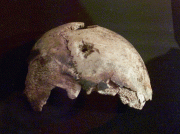
A closeup of the skull. The hole is far too small for the 7.65 mm caliber bullet Hitler used to commit suicide, one German expert has said.The bone of contention. American researchers believe it comes from a young female because the bone is relatively thin. And the exit wound of the bullet is in the wrong place, they claim.
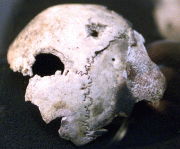
Russian secret service officials insist the skull fragments belong to Adolf Hitler, and have dismissed American reports which suggest they belong to a woman
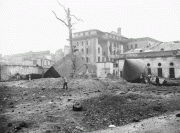
Hitler's bunker in December 1947. In May 1945, days afer Hitler and his wife Eva Braun had committed suicide, Soviet officials exhumed the bodies.
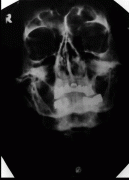
An X-ray photograph of Hitler's head dated 1944. The skull shown in Moscow is that of a woman, researchers believe.
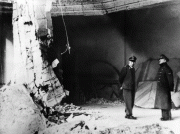
April 1945: Adolf Hitler inspects damage to his Reich Chancellery. This is one of the last photographs of the Nazi leader who committed suicide in his bunker on April 30, 1945. Russian authorities in 2000 presented a skull fragment they said belonged to him. But a recent DNA test by an American scientist found that it belonged to a woman. Russia's FSB intelligence service has now insisted that the skull fragment is Hitler's.

Eva Braun. It's not sure whether Hitler's wife shot herself. So it's unclear if the disputed skull fragment is hers.

The traditional story is that Hitler committed suicide with his lover Eva Braun as the Russians bombarded Berlin in 1945

War correspondents in 1945 are shown the grave where Adolf Hitler's charred body is alleged to have been buried, behind the Chancellery in Berlin
Russian secret service officials claim they have genuine fragments of the skull of Adolf Hitler and have dismissed American reports which suggest it belongs to a woman.
Vassili Khristoforov, head of Russia’s Federal Security Service (FSB), said: ‘The FSB archives hold the jaw of Hitler and the state archives a fragment of Hitler’s skull.
‘With the exception of these remains, seized on May 5, 1945, there exist no other bits from the body of Hitler.’
In September academics from the University of Connecticut, in the US, said their DNA analysis showed the skull fragment to be that of a woman, aged between 20 and 40.
But they did not test the jawbone, and that, say the Russians, is positively male.
The researchers had not approached the FSB archives about testing the jawbone, said Khristoforov.
‘And even if they had the DNA of our fragments, with what could they then have compared it?’ he asked.
Deep in the Lubyanka, headquarters of Russia’s secret police, a fragment of Hitler’s jaw is preserved as a trophy of the Red Army’s victory over Nazi Germany. A fragment of skull with a bullet hole lies in the State Archive.
So when American academics claimed that DNA tests showed the skull to be that of a woman, they challenged a long-cherished tale of the hunt for Hitler’s remains. Yesterday the chief archivist of the Federal Security Service (FSB) insisted that the bones were genuine and told of how the KGB destroyed almost all traces of the dictator’s corpse.
Lieutenant-General Vasily Khristoforov said that the remains had been incinerated in 1970 and the ashes thrown into a river in East Germany.
Agents under orders from the head of the KGB, Yuri Andropov, had dug up a grave containing Hitler, his wife Eva Braun and the family of his henchman Joseph Goebbels. The officers had removed the remains from a burial ground in a Soviet base at Magdeburg, Andropov having written to Soviet party chiefs recommending that the bodies be destroyed after it was decided to pass the base to East Germany.
In April 1970, Andropov compiled a report declaring that “the remains were burnt on a vacant area outside Schönebeck, 11 kilometres from Magdeburg, ground into ashes, gathered and thrown into the Biederitz river” — either the Ehle river near Biederitz suburb or the Biederitzer See.
General Khristoforov told the Interfax news agency that Hitler’s remains had been destroyed out of concern that his grave could become a Nazi shrine. “It was not worth leaving any grounds for the rise of a cult of worship . . . there are people who profess the fascist ideology, regrettably even in Russia.”
Hitler’s remains arrived in Magdeburg in early 1946 after a peripatetic eight months. The bodies of Hitler and Braun had been crudely cremated on April 30, 1945, at the site of his bunker in Berlin. He had bitten a cyanide pellet then shot himself.
When the Red Army reached the bunker they found the two charred corpses alongside the bodies of Goebbels and his wife. At first there was some doubt as to whether it was really Hitler. It was transported for examination to a field hospital near Berlin.
Hitler’s dental records were located and glass splinters found in his jawbone, suggesting that he had bitten a poison capsule. The early report made no mention of a gunshot wound, perhaps because Soviet officers did not want to anger Stalin by suggesting that Hitler had died a “hero’s death”. But in the meantime, witnesses from the bunker were telling their interrogators that Hitler had indeed shot himself.
The mixed signals must have unsettled Stalin. As long as uncertainty remained, the counterintelligence organisation Smersh and NKVD units wanted to hang on to Hitler’s remains. Every time the Smersh unit moved, Hitler went with it — buried in a wood on the fringes of Berlin, then in Rathenow, and then again when an investigation committee was set up and he was taken to Magdeburg.
Hitler’s jawbone and a fragment of his skull had been sent to the Kremlin. The rest of the remains were kept at the Soviet compound in Magdeburg until it was decided to hand the barracks to the East German military.
General Khristoforov insisted that the FSB had no reason to question the authenticity of the skull fragments in its possession. In September professors at the University of Connecticut had claimed that DNA samples showed the skull to have come from a woman aged up to 40.
General Khristoforov said: “Hitler’s jaw is at the FSB archives, the fragment of skull at the State Archive. These materials are the only documentary evidence of Hitler’s death.” He did not offer DNA proof. The jaw has never been seen in public.
‘These remains are unique, there is nothing comparable. We are talking about the only evidence of this kind of the death of Hitler, and that is why the FSB had kept it in its archives.’
The American report in October inflamed speculation that Hitler may have escaped from the blazing ruins of Berlin in 1945 instead of taking his own life in the bunker.
The piece of skull - complete with bullet hole - had been taken from outside the Fuhrer’s bunker by the Russian Army and preserved by Soviet intelligence.
The traditional story is that Hitler committed suicide with his lover Eva Braun as the Russians bombarded Berlin.
Although some historians doubted he shot himself and suggested it was Nazi propaganda to make him a hero, the hole in the skull fragment seemed to settle the argument when it was put on display in Moscow in 2000.
According to witnesses, the bodies of Hitler and Braun were wrapped in blankets and carried to the garden just outside the bunker, placed in a bomb crater, doused with petrol and set ablaze.
In May 1945 a Russian forensics team dug up what was presumed to be the dictator’s body. Part of the skull was missing, apparently the result of the suicide shot. The remaining piece of jaw matched his dental records, according to his captured dental assistants. And there was only one testicle.
A year later the missing skull fragment was found on the orders of Stalin, who remained suspicious about Hitler’s fate.
Just how and when he died is now shrouded in mystery.
Although Nick Bellantoni, an archaeologist with the University of Connecticut, insists the skull fragment does not belong to Hitler, he says it is unlikely to have belonged to Braun either, who was 33.
'There is no report of Eva Braun having shot herself or having been shot afterwards,' he said. 'Many people died near the bunker.'
Unknown to the world, the corpse then believed to be Hitler's was interred in Magdeburg, East Germany.
There it remained long after Stalin’s death in 1953.
Finally, in 1970, the KGB dug up the corpse, cremated it and secretly scattered the ashes in a river.
Only the jawbone (which remains away from public view), the skull fragment and the bloodstained sofa segments were preserved in the deep archives of Soviet intelligence.
Mr Bellantoni studied the remains after flying to Moscow to inspect the gruesome Hitler trophies at the State Archive.
He was allowed only one hour with the Hitler trove, during which time he applied cotton swabs and took DNA samples.
The samples were then flown back to Connecticut.
--------------
--------------
-------------
-----------
-----------
-----------
RELATED POSTS:-
- Richmond Police Make Sixth Arrest in Gang Rape-Friend of gang rape victim blasts school officials over safety
- Girl, 15, gang raped outside school dance while witnesses film horror attack
- 3 arrested in Calif. in alleged gang rape of girl
- Chicago Teenager's Gang-Related Beating Death Caught on Tape-2 held without bail for murder 1st degree
- Hitler Skull controvesial.Russian said yes they have it.US said it a women skull.
- Last Nazi 89 years old face trial for the murder of 28 000 Jews in Hollocasts in Poland.Ivan the Terrible.
- Shocking moments when mentally crazy man jump into bear compound .Bitten alive almost dead until police shot bear.Bear ok man ok.
- Thousands cheer 20 years since fall of Berlin Wall
- Airstrikes in Afghanistan drop by almost half -"Destroying a home or property jeopardizes the livelihood of an entire family — and creates more insurg
- Chancellor Angela Merkel defends German mission in Afghanistan
- Afghan anger after scores die in Nato air strike - ISAF air strike hit fuel truck hijacked by insurgents
- 3 survivors for Pearl Harbour recall attack
- Did Young Jesus visited England for educations?
- Michael Jackson and the history of the Moonwalk: YouTube explains it all!
- NightClub fire 112 dead due to firecracker inside clun.Anger rising.Bad management blamed.200 stampede cause deaths.
- Terrorists Attack at Russian Train 26 dead 100 injured.Bom derail train at 130kmph.
- Russian subs patrol off U.S. East Coast: officials
- Teenager who tried to rape girl, 11, avoids jail in 'pathetic' ruling.
- Kicked out aged four for ‘belting’ teachers,beat other kids,sent hour 4 times in 2 months
- Father shoot son at the stomach after son confess to sexually abusing 3 year old sister





0 comments:
Post a Comment